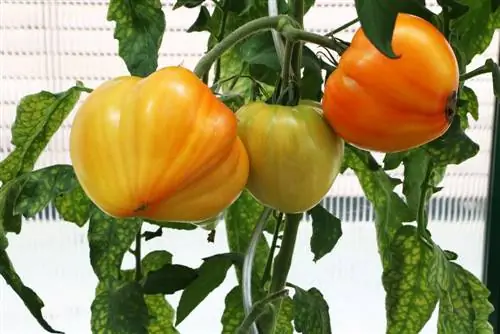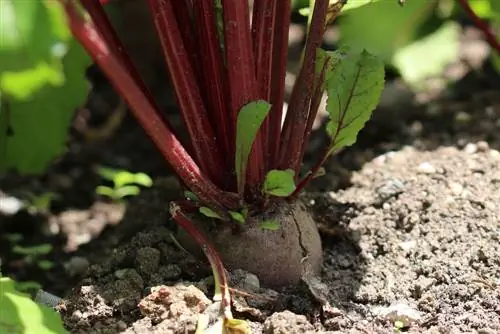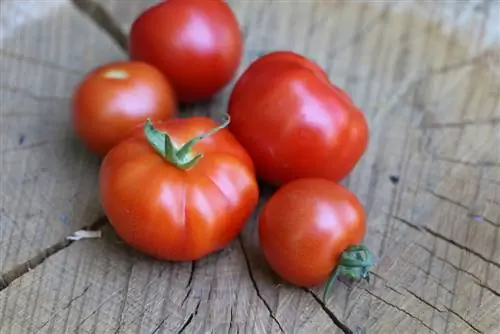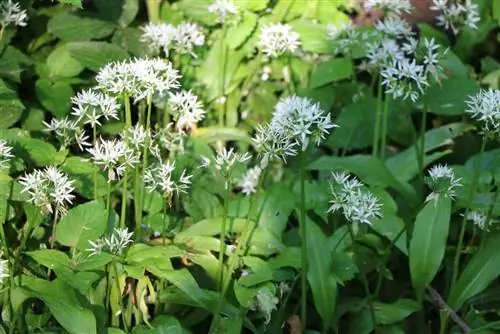- Author admin [email protected].
- Public 2023-12-17 03:39.
- Last modified 2025-01-24 12:45.
Tomatoes are one of the most popular vegetables and should not be missing from any hobby garden. Whether you prefer small cocktail tomatoes, large beefsteak tomatoes, traditional red or green, yellow or black varieties, the late summer tomato harvest is eagerly awaited. If brown spots appear on the fruit, it is most likely blossom end rot. Can you still eat the tomatoes?
Symptoms of Blossom End Rot
Blossom end rot manifests itself on tomato plants through the following symptoms:
- initially watery, then brown discoloration at the location of the flower base
- Spots enlarge
- Deformities at the shoot tips
- Deadline of leaves
- brown, gray or black spots on fruits and young leaves
- Often only individual tomatoes of the otherwise he althy-looking plant are affected
The illness
Blossom end rot is not an infestation with pests or fungi, but rather a metabolic disease. In addition to tomatoes, this can also affect cucumbers, peppers and zucchini. The causes of tomato end rot are complex.
The Causes
The most common cause of blossom end rot is an inadequate supply of calcium. The calcium deficiency causes individual cell walls to collapse and cells to die. Calcium is absorbed through the water. The fruits receive less calcium than the stems and other parts of the plant. For this reason, blossom end rot first appears on the fruit.
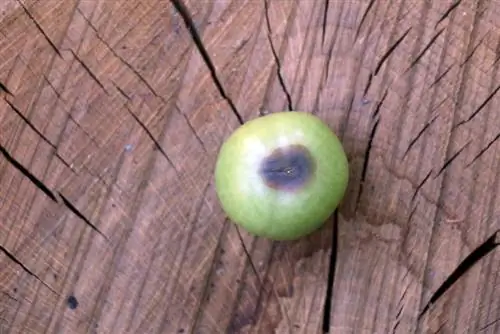
The deficiency occurs, for example, when the plant cannot absorb enough calcium. This can have various reasons. Dry soils prevent absorption. A common cause is soils rich in potassium and magnesium. These arise from over-fertilization. Nitrogen-containing fertilizer causes strong plant growth. Great care must be taken when using it, as the growth of the plant reduces its ability to absorb calcium.
Tip:
Stop throwing away eggshells carelessly. Tomatoes need calcium and eggshells contain a lot of it. Crushed eggshells are a free fertilizer and soil conditioner in your garden.
Protection against blossom end rot
If you know the requirements of tomato plants, you can protect them well from blossom end rot.
- Water your plants regularly. Tomatoes suffer from long drought.
- Avoid excessive watering.
- Provide loose, well-drained soil.
- Fertilize carefully and follow the dosage instructions. An oversupply of magnesium and potassium damages the plant.
- Check the soil pH. The optimal pH value is 6.5.
- Regulate the pH value of acidic soils by adding additional lime.
Tip:
Acid garden soils can be improved by digging in rock dust.
Are infected tomatoes edible?

Although blossom end rot usually only appears on individual fruits, while others remain intact, the question of edibility arises. The stains are watery at first, then they become larger and the tissue sinks. This change doesn't look very appetizing and many a gardener will be disappointed to throw away the tomatoes they have been looking forward to for a long time. The affected areas become increasingly harder and dry. In most cases the pulp remains intact. You can eat the tomatoes affected by blossom end rot. It is safe to consume and there is usually no loss of taste. Plants affected by blossom end rot sometimes produce damaged and intact fruits. You can enjoy these without any worries. Cut off the dark areas generously from the affected fruits. It is better to dispose of severely infested fruits completely.
Tip:
If tomatoes in your garden often suffer from blossom end rot, it is worth having a professional soil check. Send a soil sample to a testing laboratory. A few days later you will receive a comprehensive evaluation of the soil condition with tips for improvement. The test costs around 20 EUR.
Tomatoes in the greenhouse
Not only outdoor tomatoes suffer from blossom end rot, plants in the greenhouse are also affected under unfavorable conditions. In the greenhouse, poor soil quality, lack of nutrient supply and irregular irrigation are also considered to be the main causes of blossom end rot. However, there is also air circulation. High humidity and lack of ventilation lead to illness.
Tip:
Mix a casting solution from one liter of water and 30 grams of lime nitrate. Water the tomato plant with it when you notice the first signs of disease.
Are there resistant varieties?
Unfortunately, there are no tomato varieties that are protected from blossom end rot. After all, it is a nutrient deficiency, not a fungal or viral disease. What is certain, however, is that fast-growing varieties such as most beefsteak tomatoes are more often affected.

